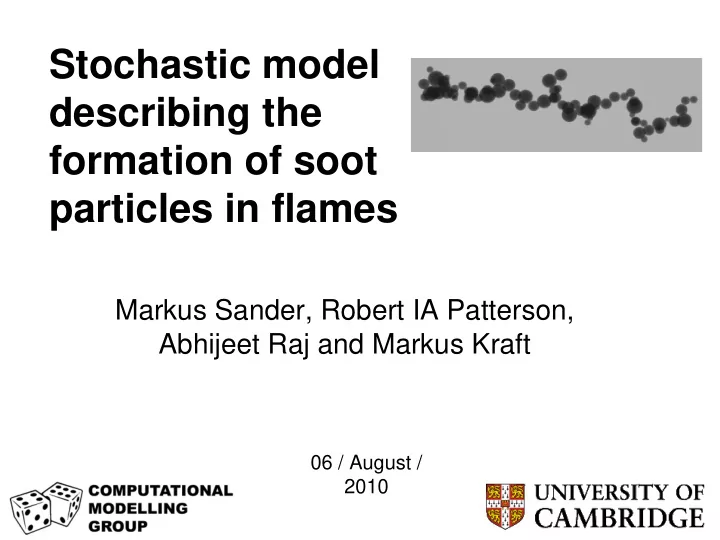

Stochastic model describing the formation of soot particles in flames Markus Sander, Robert IA Patterson, Abhijeet Raj and Markus Kraft 06 / August / 2010
Soot Formation Temperature Reaction Zone Burner Flame Carbon Addition Reactions Condensation of PAHs Particle Inception by PAHs Coalescense Aggregation Oxidation by O 2 and OH, Markus Sander ms785@cam.ac.uk
Using structural information Markus Sander ms785@cam.ac.uk
PAH reactions (selection) S1 Free-edge growth S2 Free-edge desorption S3 5-member ring addition S4 5-member ring desorption S5 Armchair growth S6 5- to 6-member ring Markus Sander Frenklach, Wang, Violi ms785@cam.ac.uk
PAH KMC growth simulation Seed molecule: Seed molecule: Pyrene Pyrene Growth of a PAH molecule – kinetic Monte Carlo (KMC) simulation Markus Sander ms785@cam.ac.uk
The PAH-PP Model Markus Sander ms785@cam.ac.uk
The Data Structure Markus Sander ms785@cam.ac.uk
The Data Structure Markus Sander ms785@cam.ac.uk
Data structure: A Binary Tree Markus Sander ms785@cam.ac.uk
Jump Processes Inception: Coagulation: Condensation: Markus Sander ms785@cam.ac.uk
Particle Rounding Coalescence level: Surface change due to particle growth: s : Smoothing factor. Markus Sander ms785@cam.ac.uk
PAH Growth inside Particles PAHs inside particles grow slower then PAHs in the gasphase: • They are notfully accessible to the gasphase. • Active sites are blocked The growth of PAHs inside particles is multiplied with the growthfactor g (0<g<1) Markus Sander ms785@cam.ac.uk
Parameter Estimation How to determine the unknown parameters? 1. The parameter range has been determined. 2. Parameters have been calculated using a low discrepency series and the model evaluated at these points. 3. The set of parameters that minimises the objective function has been chosen and further optimised using a response surface method. Markus Sander ms785@cam.ac.uk
Parameter Estimation Data points in the 3-dimensional parameter space are generated using a Halton low discrepancy series. The median d i of the particle size distribution is optimised against experimental vlues by minimising the objective function: Markus Sander ms785@cam.ac.uk
Parameter Estimation Further optimisation using a response surface approximation: Mean and variance can be expressed in terms of . Target function: Markus Sander ms785@cam.ac.uk
Parameter Estimation Where to get experimental data from? From the literature But computers are bad in reading papers! Use a machine readable format to store data. Markus Sander ms785@cam.ac.uk
Automated Model Optimisation A PrIMe XML file for a flame M. Frenklach. Transforming data into knowledge Process Informatics for combustion chemistry. Proc. Combust. Inst., 31:125–140, 2007. Markus Sander ms785@cam.ac.uk
Results Flame A2 Flame B3 Experimental data from: B. Zhao, Z. Yang, Z. Li, M. V. Johnston, and H. Wang. Particle size distribution function of incipient soot in laminar premixed ethylene flames: effect of flame temperature. Proc. Combust. Inst., 30(2):1441–1448, 2005. Markus Sander ms785@cam.ac.uk
Results 5 mm HAB 8 mm HAB 10 mm HAB 12 mm HAB Markus Sander ms785@cam.ac.uk
Results Markus Sander ms785@cam.ac.uk
Conclusion • A detailed particle model involving the connectivity of the primary particles has been presented. • A priori unknown parameters have been estimated using a combination of a low discrepancy series and a response surface optimisation. • Results have been validated against experimental data. Markus Sander ms785@cam.ac.uk
Thank you! Please visit our website: http://como.cheng.cam.ac.uk Markus Sander ms785@cam.ac.uk
Recommend
More recommend